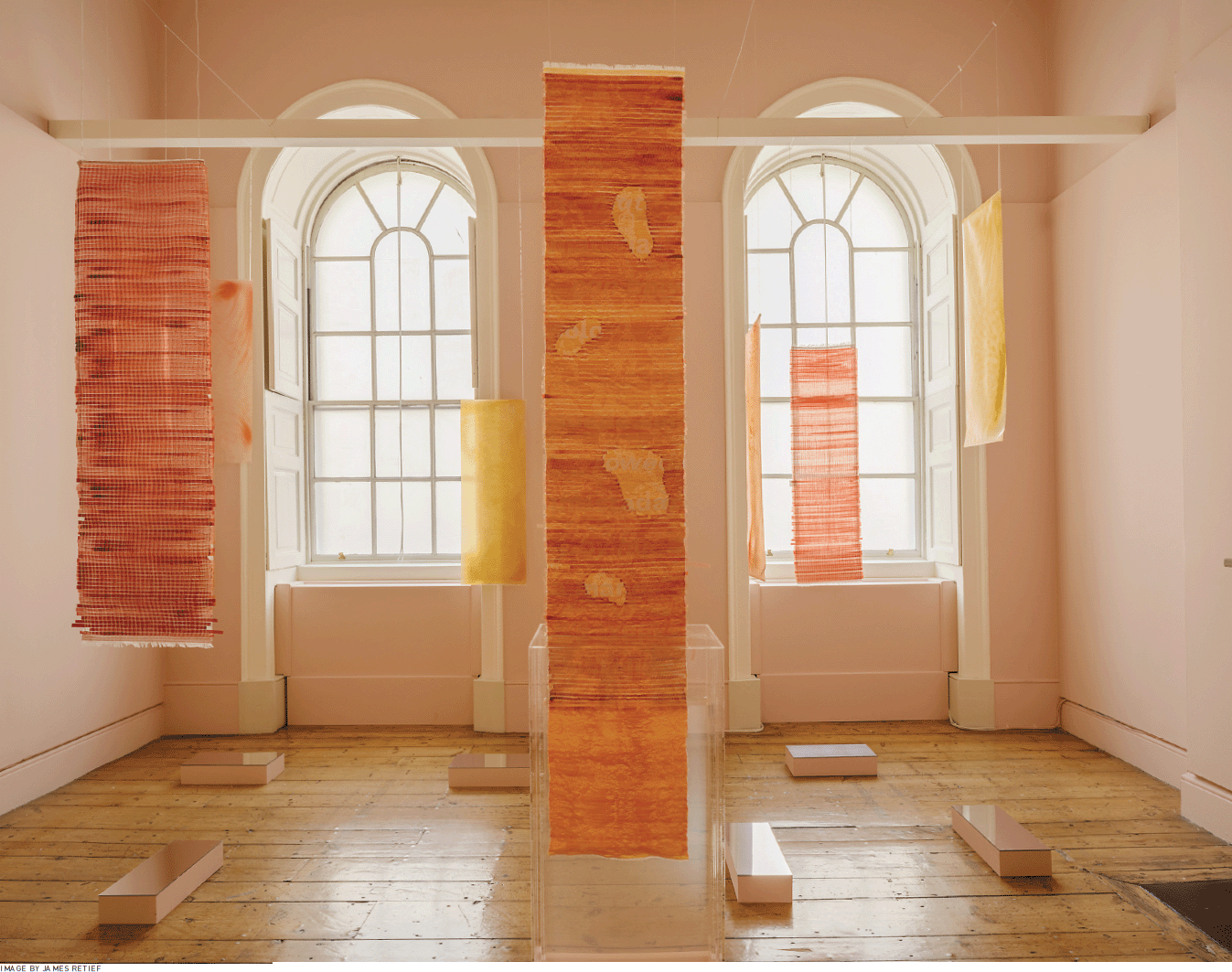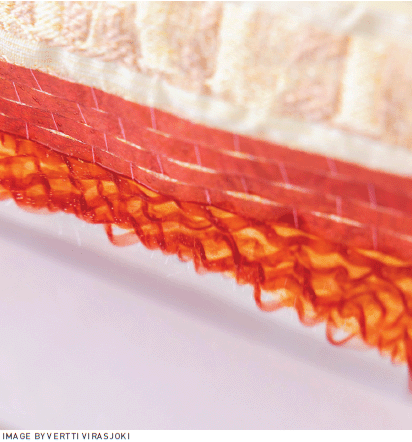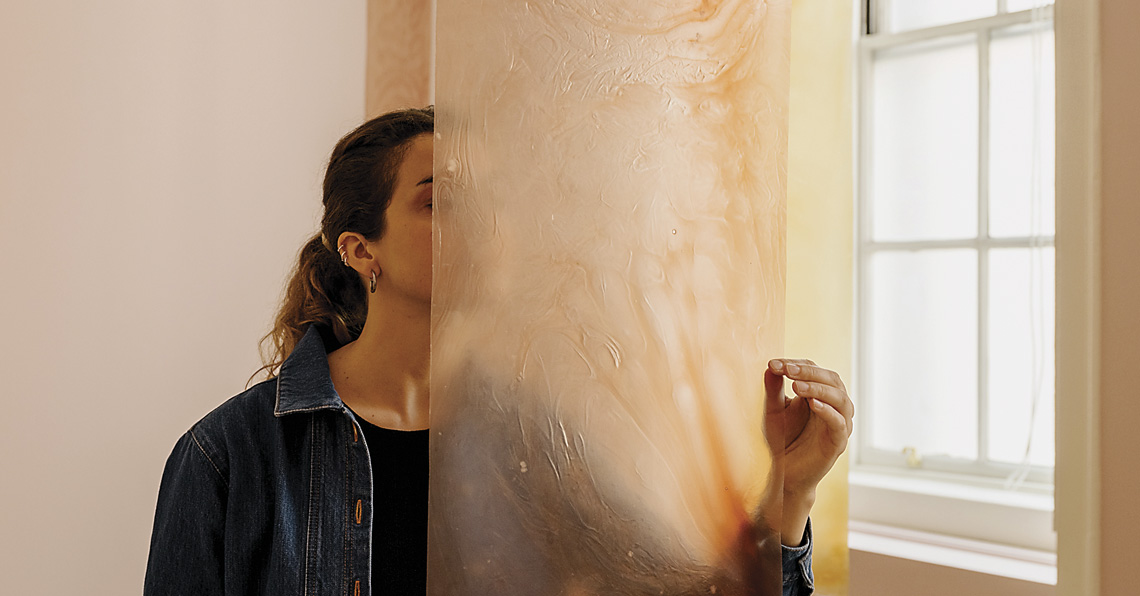Borrowed Matter/Materia Prestada
Issue: XXXI.3 May - June 2024Page: 12
Digital Citation
Authors:
Sofia Guridi
Textiles serve as interfaces, bridging our bodies and environments and enabling communication through the language of colors, shapes, textures, and scents. When combined with electronics and digital technologies, yarns take on a new dimension, enhancing messages and enabling novel interactions, such as using touch to reveal hidden sounds within a textile piece.
The growing use of these electronic textiles in the performing arts, sportswear, healthcare, and interactive installations attests to their versatility as soft interfaces connecting humans and digital systems.
However, it's essential to address the sustainability challenges arising from the fusion of textiles and electronics. Can we, therefore, create these interactive pieces from materials that are renewable, nontoxic, biodegradable, and responsibly sourced?
In what follows, I visually detail the creation process of "Borrowed Matter/Materia Prestada," an interactive multisensory installation composed of handwoven biotextile pieces. The project, which represented Chile at the London Design Biennale 2023, aimed to explore innovative uses of tree cellulose as a biomedium while provoking reflection on the extractive processes and economic considerations involved in its production.
We sought to establish a connection between biomaterial innovation and traditional techniques.
The central biotextile, partially submerged in water, underwent gradual biodegradation, symbolizing the transformation of matter and highlighting its origin as a central element in textile research. Visitors were encouraged to witness this ongoing degradation, which revealed a concealed text, and to interact with tactile sensors, uncovering hidden sounds of birds, looms, and the forest.
 | Making of cellulose films at the laboratory. The main materials are carboxymethylcellulose and natural dyes such as madder. |
 | Cellulose film ready to be cut and used. The texture is plastic-like, soft, and flexible. |
Through this installation, we sought to establish a connection between biomaterial innovation and traditional techniques, emphasizing the importance of slow, embodied making processes. Handweaving was the chosen technique due to its significance in Latin American material culture, serving as an identity marker, a means of communication, and a medium for knowledge transfer.
 | Chilean Pavilion at the London Design Biennale 2023. |
 | Design of textile pieces and preparation of weaving files utilizing Adobe Photoshop. |
 | Weaving of multilayered textiles on a TC2 hand-operated Jacquard loom. The cellulose films are combined with colored cotton yarns. |
 | Visitor touching biotextile sensor. The contact of skin on different positions of the textile piece unveil different sounds from the creation process. |
 | Detail of main piece. The first layer, made of cellulose films, degraded over the course of the exhibition, revealing a hidden text. |
 | Visitor touching a cellulose film. The exhibition was conceived to be touched, enabling embodied experiences of the novel materials. |
The biotextile pieces were meticulously crafted using cotton, natural dyes (grapes, madder, and carmine), conductive yarns, and carboxymethylcellulose, a by-product of the forest industry. This versatile biomaterial, employed in laminar format, exhibits transparency and flexibility, making it ideal for handmade textile creations. After fabricating the cellulose films, they were cut and woven to create multilayer textiles using a hand-operated Jacquard loom and a CAD wood loom.
 | Cellulose strips being pulled out of the biotextile sensor. By the end of the exhibition, one-quarter of the strips had been spontaneously taken by visitors. |
 | Detail of the water degradation of the cellulose films. |
Throughout the monthlong exhibition, the pieces transformed and degraded with the touch of visitors, exposure to natural light, and contact with water, showcasing the transient and cyclical nature of these interactive textiles. During this period, valuable insights were gathered from visitors' impressions of the materials, their aesthetic appreciation of the installation, and their thoughts on textures and colors. Adjectives such as soft, elegant, edible, calming, peaceful, and joyful provided a nuanced understanding of how people perceive the value of electronic textiles in future contexts of use, underscoring the importance of deepening our aesthetic comprehension of materials.
Surprisingly, by the exhibition's end, numerous cellulose strips had been taken away by visitors, contributing spontaneously to the partial disassembly of the electronic textiles.
Note for Spanish-speaking readers: Please see the accompanying Spanish version of the article below
This work was made possible through the collaboration of designer Sofia Guridi with curator Juan Pablo Vergara, an outstanding team of designers, and the support of Aalto University's Bioinnovation Center.
Spanish Version
Los textiles desempeñan un papel crucial como interfaces que conectan nuestros cuerpos con el entorno, permitiéndonos comunicarnos a través de colores, formas, texturas y olores. La inclusión de electrónica y tecnologías digitales en la combinación de hilos potencia los mensajes, abriendo nuevas posibilidades de interacción, como la capacidad de utilizar el tacto para descubrir sonidos ocultos en una pieza textil.
Aunque los textiles electrónicos se han integrado cada vez más en diversas áreas como las artes escénicas, la ropa deportiva, la atención médica y las instalaciones interactivas, es importante abordar los desafíos de sostenibilidad que surgen al combinar textiles y electrónicos. ¿Es factible crear estas piezas interactivas a partir de materiales renovables, no tóxicos, biodegradables y de origen responsable?
A continuación, se presenta visualmente el proceso de creación de "Borrowed Matter/Materia Prestada", una instalación multisensorial interactiva compuesta por piezas biotextiles tejidas a mano. Esta obra representó a Chile en la Bienal de Diseño de Londres 2023 . El objetivo principal era explorar los usos innovadores de la celulosa de los árboles como biomaterial, al tiempo que se reflexionaba sobre el extractivismo y el proceso económico involucrado en su producción.
El biotextil central, parcialmente sumergido en agua, experimentó una degradación gradual, retratando la transformación de la materia y su origen como elemento central de la investigación textil. Los visitantes fueron invitados a presenciar la degradación en curso, revelando un texto oculto, y a interactuar con sensores táctiles para descubrir sonidos ocultos de pájaros, telares y el bosque.
Esta instalación propuso una conexión entre la innovación de biomateriales y las técnicas tradicionales, enfatizando los procesos de creación lentos. La elección de la técnica de tejido a mano se basó en su importancia en la cultura material latinoamericana, sirviendo como elemento de identidad, medio de comunicación y medio para la transferencia de conocimientos./
Las piezas biotextiles se elaboraron a mano utilizando algodón, tintes naturales (uva, rubia y carmín), hilos conductores y carboximetilcelulosa, un subproducto de la industria forestal. Este biomaterial versátil, utilizado en formato laminar, presenta buena transparencia y flexibilidad, siendo ideal para creaciones textiles hechas a mano. Luego de la fabricación de las láminas de celulosa, se llevó a cabo el tejido utilizando un telar Jacquard manual y un telar CAD.
A lo largo del mes de la exposición, las piezas se transformaron y degradaron con el tacto de los visitantes, la luz natural y el agua, demostrando la circularidad de estos textiles interactivos.
Durante este período, se recopilaron impresiones de los visitantes sobre los materiales, su apreciación estética y sus reflexiones sobre las texturas y colores. Los adjetivos utilizados, como suave, elegante, comestible, calmante y alegre, reflejan la percepción del valor de estos biotextiles electrónicos en futuros contextos de uso y la importancia de profundizar en la comprensión estética de los materiales.
Al concluir la exhibición, los visitantes incluso se llevaron espontáneamente láminas de celulosa, contribuyendo al desmontaje parcial de los textiles electrónicos.
Agradecimientos:
Este trabajo fue llevado a cabo por Sofía Guridi, en colaboración con el curador Juan Pablo Vergara, un equipo de diseñadores excepcionales y el respaldo del Centro de Bioinnovación de la Universidad Aalto.
Sofia Guridi is a designer specializing in the intersection of textiles, electronics, and biomaterials for creating interactive surfaces. She is part of the Fashion/Textiles Futures research group and the Bioinnovation Center at Aalto University, where she is pursuing her Ph.D. on sustainable smart textiles. [email protected]
Copyright held by author
The Digital Library is published by the Association for Computing Machinery. Copyright © 2024 ACM, Inc.


